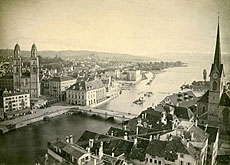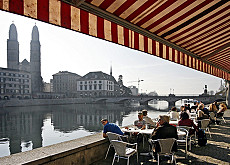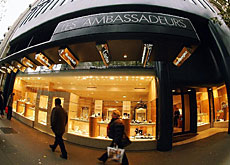Photos reveal Zurich’s globalisation

Zurich, Switzerland's financial hub, has become a global city that regularly tops the lists of the best places to live worldwide. But this was not always the case.
A new exhibition of photos drawn from the city’s Archives for Building History shows how in the late 19th century Zurich transformed itself from a medieval city to a bustling metropolis.
The images, on show at the Swiss National Museum in Zurich until the end of September, offer a glimpse of what life was like in Zurich between 1850 and 1900.
This was a tremendously exiting period as the city was undergoing radical change, with new buildings – signs of its modernity and newfound wealth – springing up across Zurich.
“During this time a lot of representative buildings emerged such as banks, the station, the universities and the hospital,” Thomas Meyer, head of the Archives for Building History, told swissinfo.
“This was a departure from a city still influenced by its medieval heritage – the city wall and narrow streets in the old town,” he explained.
An important catalyst for Zurich’s change was industrialisation. Factories appeared in the city and as a result the population swelled.
The main station was also a factor. A photograph from 1882, taken a few years after it opened, shows a spacious area with only a few people and vehicles.
It hardly bears any resemblance to the built-up and more crowded station of 2007, which is now surrounded by a well-used road and multiple tramlines.
Meyer says the station allowed cargo, such as coal, to be brought in to fuel the factories. The whole project had the strong support of the banks and the city’s liberal politicians.
Alfred Escher
One key figure was railway baron and Credit Suisse founder Alfred Escher, a dominant character in Zurich – and national – politics in the 19th century.
Escher understood the importance of having a railway network and financial centre. He also championed the founding of Zurich’s Federal Institute of Technology, now a leading university.
Other changes to the city included the building of the famous shopping street, Bahnhofstrasse, which involved clearing away some of the old Zurich.
In one photo, taken just before work began on Bahnhofstrasse, a medieval tower can still be seen. Its site is now occupied by the Orell Füssli English Bookstore.
Meyer explained that tearing down the old city wall allowed Zurich to expand outwards to meet its demand for more space.
However, a view of the city taken in 1890 shows that it was much smaller than today. The old town and the city centre are built up, but the surroundings – now greater Zurich – are still pure countryside.
Leisure time
The late 19th century was also when Zurich’s industrious residents discovered the concept of leisure time.
The lakeside was consequently built up and strolling along it became a popular pastime. One photo even shows people enjoying a walk on a frozen Lake Zurich, an event that happened several times in the 19th century.
However, Meyer says that it is not possible to know what the Zurich people felt about their new city.
“Did they welcome it or were they critical? Were they pleased about the bigger city or against the old buildings going?” said Meyer. “It could have been like the discussions of today.”
Indeed, Switzerland’s largest city is still changing and adding new quarters, such as Zurich West, a fashionable area on an old industrial site, or the Sihlcity shopping mall.
Nevertheless these photos of a bygone age – taken by local professionals and travelling photographers – still have the ability to fascinate, says Meyer.
“People are interested in knowing what where they live looked like in the old days. It has an emotional appeal,” he explained.
“So if people are now tempted to dig a little bit deeper into history and think about the changes to the city, we’ve done a good job.”
swissinfo, Isobel Leybold-Johnson in Zurich
The “Zurich in the viewfinder, 1850-1900,” exhibition runs at the Swiss National Museum until September 30, 2007.
It contains a selection of some of the best and oldest photos from the more than 100,000 images in the Zurich Archives for Building History.
The Archives for Building History continues to update its collection. It can be visited by the public.
Zurich is Switzerland’s largest city with 370,000 residents. There are almost one million residents within its metropolitan area.
The city regularly tops the rankings in the world when it comes to quality of life. It scores well in terms of safety, cleanliness, culture and leisure areas.
It is Switzerland’s economic centre, the largest marketplace for gold and houses the fourth-most important stock exchange in the world (after New York, London and Tokyo).
Many international companies, such as IBM and Google have their headquarters in the city. The big Swiss banks UBS and Credit Suisse as well as the world’s largest reinsurer Swiss Re are also based in Zurich.

In compliance with the JTI standards
More: SWI swissinfo.ch certified by the Journalism Trust Initiative




You can find an overview of ongoing debates with our journalists here. Please join us!
If you want to start a conversation about a topic raised in this article or want to report factual errors, email us at english@swissinfo.ch.